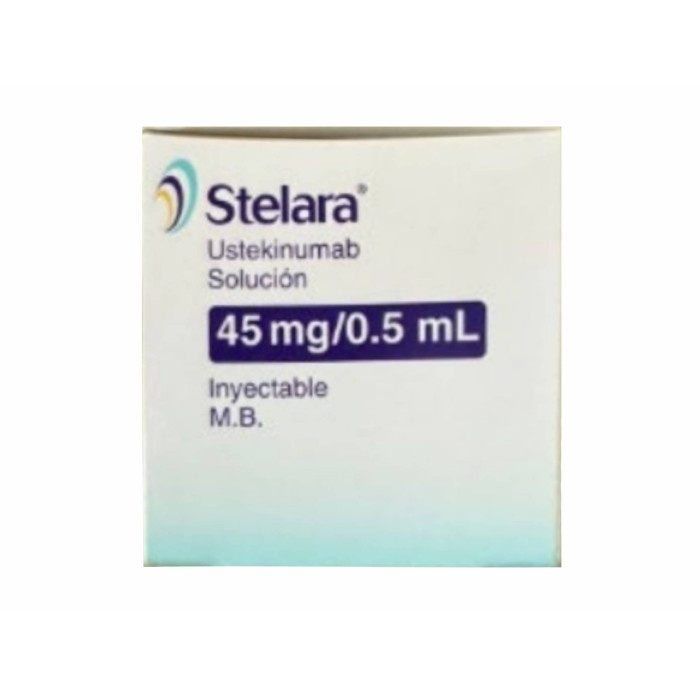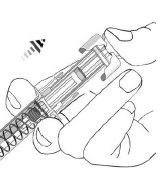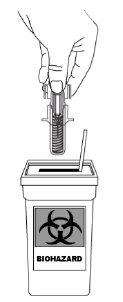
How to use STELARA 45 mg SOLUTION FOR INJECTION IN PRE-FILLED SYRINGE
Introduction
Package Leaflet: Information for the Patient
STELARA 45 mg solution for injection in pre-filled syringe
ustekinumab
Read all of this leaflet carefully before you start using this medicine because it contains important information for you.
This leaflet has been written for the person taking the medicine. If you are the parent or carer of a child who will be taking Stelara, please read this information carefully.
- Keep this leaflet, you may need to read it again.
- If you have any further questions, ask your doctor or pharmacist.
- This medicine has been prescribed for you only. Do not pass it on to others. It may harm them, even if their signs of illness are the same as yours.
- If you get any side effects, talk to your doctor or pharmacist. This includes any possible side effects not listed in this leaflet. See section 4.
Contents of the pack
- What is Stelara and what is it used for
- What you need to know before you use Stelara
- How to use Stelara
- Possible side effects
- Storage of Stelara
- Contents of the pack and further information
1. What is Stelara and what is it used for
What is Stelara
Stelara contains the active substance “ustekinumab”, a monoclonal antibody. Monoclonal antibodies are proteins that identify and bind to specific proteins in the body.
Stelara belongs to a group of medicines called “immunosuppressants”. These medicines work by weakening part of the immune system.
What is Stelara used for
Stelara is used to treat the following inflammatory diseases:
- Plaque psoriasis - in adults and children aged 6 years and over
- Psoriatic arthritis - in adults
- Moderate to severe Crohn's disease - in adults
- Moderate to severe ulcerative colitis - in adults
Plaque psoriasis
Plaque psoriasis is a skin disease that causes inflammation affecting the skin and nails. Stelara reduces inflammation and other signs of the disease.
Stelara is used in adults with moderate to severe plaque psoriasis who cannot use cyclosporin, methotrexate, or phototherapy, or where these treatments do not work.
Stelara is used in children and adolescents aged 6 years and over with moderate to severe plaque psoriasis who are unable to tolerate phototherapy or other systemic therapies or where these treatments do not work.
Psoriatic arthritis
Psoriatic arthritis is an inflammatory disease of the joints, usually accompanied by psoriasis. If you have active psoriatic arthritis, you will first receive other medicines. If you do not respond well to these medicines, you may be treated with Stelara to:
- Reduce the signs and symptoms of your disease.
- Improve your physical function.
- Reduce damage to your joints.
Crohn's disease
Crohn's disease is an inflammatory disease of the intestine. If you have Crohn's disease, you will first be given other medicines. If you do not respond adequately or do not tolerate these medicines, you may be given Stelara to reduce the signs and symptoms of your disease.
Ulcerative colitis
Ulcerative colitis is an inflammatory disease of the intestine. If you have ulcerative colitis, you will first be given other medicines. If you do not respond well enough or do not tolerate these medicines, you may be given Stelara to reduce the signs and symptoms of your disease.
2. What you need to know before you use Stelara
Do not use Stelara:
- If you are allergic to ustekinumabor any of the other ingredients of this medicine (listed in section 6).
- If you have an active infectionthat your doctor thinks is important.
If you are not sure if any of the above applies to you, talk to your doctor or pharmacist before using Stelara.
Warnings and precautions
Talk to your doctor or pharmacist before starting Stelara. Your doctor will check how you are before each treatment. Make sure to tell your doctor about any illness you have before each treatment. Your doctor will also ask if you have recently been near someone who might have tuberculosis. Your doctor will examine you and do a test to detect tuberculosis before you use Stelara. If your doctor thinks you are at risk of tuberculosis, they may give you medicines to treat it.
Observe serious side effects
Stelara may cause serious side effects, including allergic reactions and infections. You should pay attention to certain signs of illness while using Stelara. See the complete list of these side effects in “Serious side effects” in section 4.
Before using Stelara, tell your doctor:
- If you have ever had an allergic reaction to Stelara.Talk to your doctor if you are not sure.
- If you have ever had any type of cancer– this is because immunosuppressants like Stelara weaken part of the immune system. This may increase the risk of having cancer.
- If you have had a recent infection.
- If you have any new or changing lesionswithin the area of psoriasis or on intact skin.
- If you have ever had an allergic reaction to latex or to the injection of Stelara– the container of this medicine contains latex, which may cause serious allergic reactions in people who are sensitive to latex. See “Observe serious side effects” in section 4 for signs of an allergic reaction.
- If you are taking any other treatment for psoriasis and/or psoriatic arthritis– such as any other immunosuppressant or phototherapy (when your body is treated with a type of ultraviolet light (UV)). These treatments may also weaken part of the immune system. It has not been studied whether these treatments can be used together with Stelara. However, it is possible that it may increase the likelihood of suffering from diseases related to a weaker immune system.
- If you are receiving or have ever received allergy shots– it is not known if Stelara can affect these treatments.
- If you are 65 years of age or older– you are more likely to get infections.
If you are not sure if you have any of these conditions, talk to your doctor or pharmacist before using Stelara.
Children and adolescents
Stelara is not recommended for use in children under 6 years of age with psoriasis or in children under 18 years of age with psoriatic arthritis, Crohn's disease, or ulcerative colitis, as it has not been studied in this age group.
Using Stelara with other medicines, vaccines
Tell your doctor or pharmacist:
- If you are using, have recently used, or might use other medicines.
- If you have been vaccinated recently or are going to have a vaccination.Certain types of vaccines (live vaccines) should not be given while you are using Stelara.
Pregnancy and breastfeeding
- It is recommended to avoid using Stelara during pregnancy.The effects of Stelara in pregnant women are not known. If you are a woman of childbearing age, you are advised to avoid becoming pregnant and to use adequate contraceptive measures while you are using Stelara and for at least 15 weeks after the last treatment with Stelara.
- Tell your doctor if you are pregnant, think you may be pregnant, or plan to become pregnant.
- Tell your doctor if you are breastfeeding or plan to breastfeed.You and your doctor will decide whether you should breastfeed or use Stelara. Do not do both.
Driving and using machines
Stelara has no or negligible influence on the ability to drive and use machines.
3. How to use Stelara
Stelara should be used under the guidance and supervision of a doctor with experience in the treatment of the conditions for which STELARA is indicated.
Always follow exactly the instructions of your doctor for the administration of this medicine. If you are not sure, ask your doctor. Ask your doctor when you should have the injections and about follow-up appointments.
How much Stelara is given
Your doctor will decide how much Stelara you need to use and the duration of treatment.
Adults aged 18 years and over
Psoriasis or psoriatic arthritis
- The recommended starting dose is 45 mg of Stelara.Patients weighing more than 100 kilograms (kg) may start with a dose of 90 mg instead of 45 mg.
- After the initial dose, you will take the next dose 4 weeks later and then every 12 weeks.The following doses are usually the same as the starting dose.
Crohn's disease or ulcerative colitis
- During treatment, your doctor will give you the first dose of approximately 6 mg/kg of Stelara by infusion into a vein in your arm (intravenous infusion).After the initial dose, you will receive the next dose of 90 mg of Stelara 8 weeks later and then every 12 weeks, by injection under the skin (“subcutaneously”).
- In some patients, after the first injection under the skin, 90 mg of Stelara will be administered every 8 weeks.Your doctor will decide when you should receive the next dose.
Children and adolescents aged 6 years and over Psoriasis
- Your doctor will tell you the correct dose for you, including the amount (volume) of Stelara to inject to give the correct dose.The dose that is right for you will depend on your body weight at the time of each dose.
- A vial of 45 mg is available for children who need to receive less than the full dose of 45 mg.
- If you weigh less than 60 kg, the recommended dose is 0.75 mg of Stelara per kg of body weight.
- If you weigh between 60 kg and 100 kg, the recommended dose is 45 mg of Stelara.
- If you weigh more than 100 kg, the recommended dose is 90 mg of Stelara.
- After the initial dose, you will receive the next dose 4 weeks later, and then every 12 weeks.
How Stelara is given
- Stelara is given by injection under the skin (“subcutaneously”).At the start of your treatment, medical or nursing staff may inject Stelara for you.
- However, you and your doctor may decide that you will inject Stelara yourself.In this case, you will be trained on how to inject Stelara yourself.
- For instructions on how to inject Stelara, see “Administration instructions” at the end of this leaflet.
Talk to your doctor if you have any questions about how to inject yourself.
If you use more Stelara than you should
If you have used or been given too much Stelara, talk to your doctor or pharmacist immediately.
Always carry the medicine box with you, even if it is empty.
If you forget to use Stelara
If you miss a dose, talk to your doctor or pharmacist. Do not take a double dose to make up for forgotten doses.
If you stop using Stelara
Stopping Stelara is not dangerous. However, if you stop using it, your symptoms may come back.
If you have any other questions about using this medicine, ask your doctor or pharmacist.
4. Possible side effects
Like all medicines, this medicine can cause side effects, although not everybody gets them.
Serious side effects
Some patients may have serious side effects that may need urgent treatment.
Allergic reactions – these may need urgent treatment. Contact your doctor or get emergency medical help immediately if you notice any of the following signs.
- Severe allergic reactions (“anaphylaxis”) are rare in people using Stelara (may affect up to 1 in 1,000 people).Signs include:
- difficulty breathing and swallowing
- low blood pressure, which can cause dizziness or mild headaches
- swelling of the face, lips, mouth, or throat.
- Common signs of an allergic reaction include skin rash and hives (these may affect up to 1 in 100 people).
In rare cases, allergic reactions in the lungs and inflammation of the lungs have been reported in patients treated with ustekinumab. Tell your doctor immediately if you have symptoms such as cough, difficulty breathing, and fever.
If you have a severe allergic reaction, your doctor may decide that you should not use Stelara again.
Infections – these may need urgent treatment. Contact your doctor immediately if you notice any of these signs.
- Nose or throat infections and the common cold are common (may affect up to 1 in 10 people).
- Chest infections are uncommon (may affect up to 1 in 100 people).
- Inflammation of the tissues under the skin (“cellulitis”) is uncommon (may affect up to 1 in 100 people).
- Herpes (a type of painful rash with blisters) is uncommon (may affect up to 1 in 100 people).
Stelara may affect your ability to fight infections, and some of these may become serious.
You should watch for signs of infection while you are using Stelara. These include:
- fever, flu-like symptoms, night sweats
- feeling tired or having trouble breathing; cough that does not go away
- having hot, red, and painful skin or a painful skin rash with blisters
- pain when urinating
- diarrhea.
Talk to your doctor immediately if you notice any of these signs of infection, as they may be signs of infections such as chest infections, or skin or herpes infections that could have serious complications. You should also tell your doctor if you have any type of infection that does not go away or comes back. Your doctor may decide that you should not use Stelara until the infection goes away. Also, talk to your doctor if you have any open cuts or ulcers that could become infected.
Shedding of the skin – increased redness and shedding of the skin over a large area of the body may be symptoms of erythrodermic psoriasis or exfoliative dermatitis, which are serious skin disorders. If you notice any of these symptoms, you should tell your doctor immediately.
Other side effects
Common side effects(may affect up to 1 in 10 people):
- Diarrhea
- Nausea
- Vomiting
- Feeling tired
- Feeling dizzy
- Headache
- Itching (“pruritus”)
- Back, muscle, or joint pain
- Sore throat
- Redness and pain at the injection site
- Sinusitis
Uncommon side effects(may affect up to 1 in 100 people):
- Dental infections
- Vaginal yeast infections
- Depression
- Nasal congestion or stuffiness
- Bleeding, bruising, hardening, swelling, and itching at the injection site
- Feeling weak
- Drooping eyelid and sinking of the muscles on one side of the face (“facial palsy” or “Bell's palsy”), which is usually temporary
- A change in psoriasis with redness and new small, yellow or white bumps on the skin, sometimes accompanied by fever (pustular psoriasis)
- Shedding of the skin (exfoliation of the skin)
- Acne
Rare side effects(may affect up to 1 in 1,000 people):
- Redness and shedding of the skin over a large area of the body, which may be itchy or painful (exfoliative dermatitis).Similar symptoms may develop, such as a natural change in the symptoms of psoriasis (erythrodermic psoriasis)
- Inflammation of small blood vessels, which may cause a skin rash with small red or purple bumps, fever, or joint pain (vasculitis)
Reporting of side effects
If you experience any side effects, talk to your doctor or pharmacist, even if it is possible that they are not listed in this leaflet. You can also report side effects directly through the national reporting system listed in Appendix V. By reporting side effects, you can help provide more information on the safety of this medicine.
5. Storage of Stelara
- Keep this medication out of sight and reach of children.
- Store in the refrigerator (2 °C–8 °C). Do not freeze.
- Keep the prefilled syringe in the outer packaging to protect it from light.
- If necessary, individual Stelara prefilled syringes may also be stored at room temperature up to 30°C for a single period of up to 30 days in their original carton to protect them from light. Write the date when the prefilled syringe is first removed from the refrigerator and the date when it should be discarded on the spaces provided on the outer packaging. The discard date should not exceed the original expiration date printed on the carton. Once a syringe has been stored at room temperature (up to a maximum of 30°C), it should not be returned to the refrigerator. Discard the syringe if it is not used within 30 days of room temperature storage or the original expiration date, whichever comes first.
- Do not shake the Stelara prefilled syringes. Prolonged vigorous shaking may damage the product.
Do not use this medication:
- After the expiration date stated on the label and carton after "EXP". The expiration date is the last day of the month indicated.
- If the liquid changes color, is cloudy, or contains any visible particles (see section 6 "Appearance of Stelara and package contents").
- If you know or think you have been exposed to extreme temperatures (such as accidental heating or freezing).
- If the product has been vigorously shaken.
Stelara is for single use only. You should discard any unused product remaining in the syringe. Medicines should not be disposed of via wastewater or household waste. Ask your pharmacist how to dispose of medicines no longer required. This will help protect the environment.
6. Package contents and additional information
Composition of Stelara
- The active substance is ustekinumab. Each prefilled syringe contains 45 mg of ustekinumab in 0.5 ml.
- The other ingredients are L-histidine, L-histidine monohydrochloride monohydrate, polysorbate 80, sucrose, and water for injections.
Appearance of Stelara and package contents
Stelara is a clear to slightly opalescent (with a pearly sheen) injectable solution, colorless to light yellow. The solution may contain a few translucent or white protein particles.
It is presented in a pack containing 1 prefilled syringe of 1 ml glass. Each prefilled syringe contains 45 mg of ustekinumab in 0.5 ml of injectable solution.
Marketing Authorisation Holder
Janssen-Cilag International NV
Turnhoutseweg 30
B-2340 Beerse
Belgium
Manufacturer
Janssen Biologics B.V.
Einsteinweg 101
2333 CB Leiden
Netherlands
You can request more information about this medicinal product from the local representative of the Marketing Authorisation Holder:
België/Belgique/BelgienLietuva
Janssen-Cilag NV UAB "JOHNSON & JOHNSON"
Tel/Tél: + 32 14 64 94 11 Tel: +370 5 278 68 88
[email protected] [email protected]
БългарияLuxembourg/Luxemburg
„Джонсън и Джонсън“ ЕООД Janssen-Cilag NV
Тел.: +359 2 489 94 00 Tél/Tel: +32 14 64 94 11
[email protected] [email protected]
Ceská republikaMagyarország
Janssen-Cilag s.r.o. Janssen-Cilag Kft.
Tel: +420 227 012 227 Tel.: +36 1 884 2858
DanmarkMalta
Janssen-Cilag A/S AM MANGION LTD
Tlf: +45 4594 8282 Tel: +356 2397 6000
DeutschlandNederland
Janssen-Cilag GmbH Janssen-Cilag B.V.
Tel: +49 2137 955 955 Tel: +31 76 711 1111
[email protected] [email protected]
EestiNorge
UAB "JOHNSON & JOHNSON" Eesti filiaal Janssen-Cilag AS
Tel: +372 617 7410 Tlf: + 47 24 12 65 00
[email protected] [email protected]
ΕλλάδαÖsterreich
Janssen-Cilag Φαρμακευτική Α.Ε.Β.Ε. Janssen-Cilag Pharma GmbH
Τηλ: +30 210 80 90 000 Tel: +43 1 610 300
EspañaPolska
Janssen-Cilag, S.A. Janssen-Cilag Polska Sp. z o.o.
Tel: +34 91 722 81 00 Tel.: + 48 22 237 60 00
FrancePortugal
Janssen-Cilag Janssen-Cilag Farmacêutica, Lda.
Tél: 0 800 25 50 75 / +33 1 55 00 40 03 Tel: +351 214 368 600
HrvatskaRomânia
Johnson & Johnson S.E. d.o.o. Johnson & Johnson România SRL
Tel: +385 1 6610 700 Tel: +40 21 207 1800
IrelandSlovenija
Janssen Sciences Ireland UC Johnson & Johnson d.o.o.
Tel: +353 1 800 709 122 Tel. +386 1 401 18 00
ÍslandSlovenská republika
Janssen-Cilag AB Johnson & Johnson, s.r.o.
c/o Vistor hf. Tel: +421 232 408 400
Sími: +354 535 7000
ItaliaSuomi/Finland
Janssen-Cilag SpA Janssen-Cilag Oy
Tel: 800.688.777 / +39 02 2510 1 Puh/Tel: +358 207 531 300
[email protected] [email protected]
ΚύπροςSverige
Βαρνάβας Χατζηπαναγής Λτδ Janssen-Cilag AB
Τηλ: +357 22 207 700 Tfn: +46 8 626 50 00
LatvijaUnited Kingdom
UAB "JOHNSON & JOHNSON" filiale Janssen-Cilag Ltd.
Latvija Tel: +44 1 494 567 444
Tel: +371 678 93561
Dateof last revision of this leaflet{MM/AAAA}.
Detailed information on this medicinal product is available on the European Medicines Agency web site: http://www.ema.europa.eu/.
Administration instructions
At the start of treatment, your healthcare professional will help you with your first injection. However, you and your doctor may decide that you can inject Stelara yourself. In this case, they will teach you how to inject Stelara. Talk to your doctor if you have any questions about administering the injections.
- Do not mix Stelara with other injectable liquids.
- Do not shake the Stelara prefilled syringes. The medicine may be damaged if shaken vigorously. Do not use the medicine if it has been shaken vigorously.
Figure 1 shows what the prefilled syringe looks like.
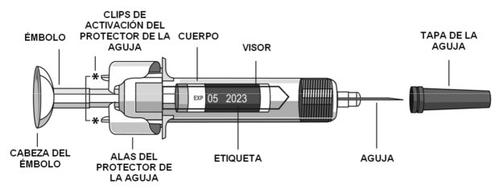
Figure 1
- Check the number of prefilled syringes and prepare the materials:Preparation for using the prefilled syringe
?Take the prefilled syringe(s) out of the refrigerator. Leave the prefilled syringe out of the carton for 30 minutes. This will allow the liquid to reach a comfortable temperature for injection (room temperature). Do not remove the needle cap while waiting for the syringe to reach room temperature.
?Hold the prefilled syringe by the body with the needle shield facing upwards.
?Do not hold the syringe by the plunger, the plunger rod, the wings of the needle shield, or the needle cap.
?Do not remove the plunger at any time.
?Do not remove the prefilled syringe cap until you are instructed to do so.
?Do not touch the activation clips of the needle shield (indicated by asterisks* in Figure 1) to avoid the needle shield covering the needle prematurely.
Check the prefilled syringe(s) to ensure that
- The number of prefilled syringes and the concentration are correct
- If your dose is 45 mg, you will have one 45 mg Stelara prefilled syringe.
- If your dose is 90 mg, you will have two 45 mg Stelara prefilled syringes and you will need to administer two injections. Choose two different injection sites (e.g., one in the right thigh and one in the left thigh), and inject one after the other.
- It is the correct medicine.
- The expiration date has not passed.
- The prefilled syringe is not damaged.
- The solution in the prefilled syringe is clear to slightly opalescent (with a pearly sheen) and colorless to light yellow.
- The solution in the prefilled syringe does not have an abnormal color, is not cloudy, or contains any visible particles.
- The solution in the prefilled syringe is not frozen.
Prepare all the materials you need and place them on a clean surface, including antiseptic wipes, cotton or gauze, and a container for sharp objects.
- Choose and prepare the injection site:Choose the injection site (see Figure 2).
?Stelara is administered by injection under the skin (subcutaneously).
?Suitable injection sites include the top of the thigh or the abdomen (at least 5 cm from the navel).
?Where possible, do not use areas of skin that show signs of psoriasis.
?If someone else is administering the injection, they may also choose the top of the arm as an injection site.
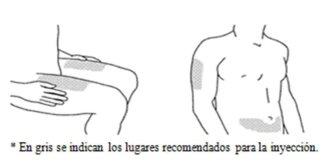
Figure 2
Prepare the injection site
- Wash your hands thoroughly with soap and warm water.
- Clean the skin at the injection site with an antiseptic wipe.
- Do not touch this area again before administering the injection.
- Remove the needle cap (see Figure 3):
- The needle cap must notbe removed until you are ready to inject.
- Hold the prefilled syringe, and hold the body of the prefilled syringe with one hand.
- Remove the needle cap and dispose of it. Do not touch the plunger while doing this.
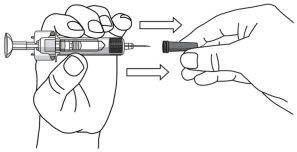
Figure 3
- You may notice an air bubble in the prefilled syringe or a drop of liquid at the end of the needle. Both are normal and do not need to be removed.
- Do not touch the needle or allow it to touch any surface.
- Do not use the prefilled syringe if it has been dropped without the needle cap. If this happens, inform your doctor or pharmacist.
- Inject the dose immediately after removing the needle cap.
- Inject the dose:
- Hold the prefilled syringe with one hand between the index and middle fingers, place your thumb on the plunger head, and with the other hand gently pinch a cleaned skin fold between the thumb and index fingers. Do not squeeze.
- Do not remove the plunger at any time.
- With a single quick motion, insert the needle through the skin at the injection site until it reaches the stop (see Figure 4).
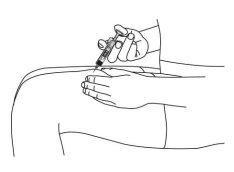
Figure 4
- Inject all of the medicine by pushing the plunger until the plunger head is completely between the wings of the needle shield (see Figure 5).

Figure 5
- When you have pushed the plunger as far as it will go, maintain pressure on the plunger head, remove the needle, and release the skin (see Figure 6).
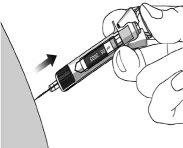
Figure 6
- Slowly remove your thumb from the plunger head to allow the empty syringe to move until the needle is completely covered by the needle shield, as shown in Figure 7:
|
Figure 7 |
- After the injection:
- Press the injection site with an antiseptic wipe for a few seconds after the injection.
- A small amount of blood or liquid may appear at the injection site. This is normal.
- You can press the injection site with a cotton ball or gauze and hold it for 10 seconds.
- Do not rub the skin at the injection site. You can cover the injection site with a plaster if necessary.
- Disposal:
- Used syringes must be placed in a puncture-resistant container, such as a sharps container (see Figure 8). For your safety and the safety of others, never reuse the syringe. Dispose of your sharps container according to local regulations.
- Antiseptic wipes and other materials can be disposed of in the trash.
|
Figure 8 |
- Country of registration
- Active substance
- Prescription requiredYes
- Manufacturer
- This information is for reference only and does not constitute medical advice. Always consult a licensed doctor before taking any medication. Oladoctor is not responsible for medical decisions based on this content.
- Alternatives to STELARA 45 mg SOLUTION FOR INJECTION IN PRE-FILLED SYRINGEDosage form: INJECTABLE PERFUSION, 130 mgActive substance: ustekinumabManufacturer: Accord Healthcare S.L.U.Prescription requiredDosage form: INJECTABLE, 45 mgActive substance: ustekinumabManufacturer: Accord Healthcare S.L.U.Prescription requiredDosage form: INJECTABLE, 90 mgActive substance: ustekinumabManufacturer: Accord Healthcare S.L.U.Prescription required
Online doctors for STELARA 45 mg SOLUTION FOR INJECTION IN PRE-FILLED SYRINGE
Discuss dosage, side effects, interactions, contraindications, and prescription renewal for STELARA 45 mg SOLUTION FOR INJECTION IN PRE-FILLED SYRINGE – subject to medical assessment and local rules.



